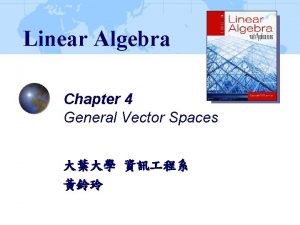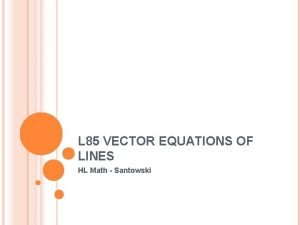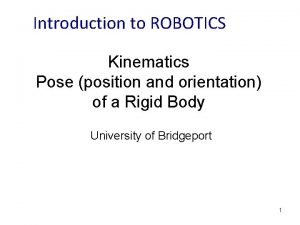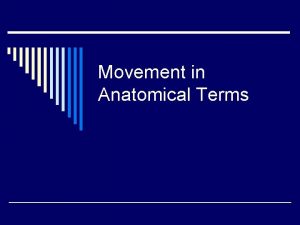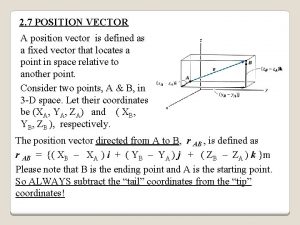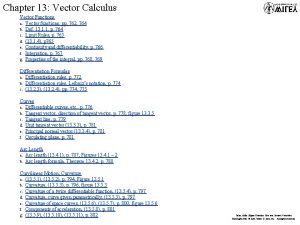POSITION VECTOR A position vector is defined as










- Slides: 10

POSITION VECTOR A position vector is defined as a fixed vector that locates a point in space relative to another point. Consider two points, A and B, in 3 -D space. Let their coordinates be (XA, YA, ZA) and (XB, YB, ZB ), respectively.

POSITION VECTOR The position vector directed from A to B, r AB , is defined as r AB = {( XB – XA ) i + ( YB – YA ) j + ( ZB – ZA ) k }m Please note that B is the ending point and A is the starting point. ALWAYS subtract the “tail” coordinates from the “tip” coordinates!

Optional Way for 3 D forces when a FORCE VECTOR DIRECTED ALONG A LINE using position and unit vectors: If a force is directed along a line, then we can represent the force vector in Cartesian coordinates by using a unit vector and the force’s magnitude. So we need to: a) Find the position vector, r. AB , along two points on that line. b) Find the unit vector describing the line’s direction, u. AB = (r. AB/r. AB). c) Multiply the unit vector by the magnitude of the force, F = F u. AB.

EXAMPLE Given: The 420 N force along the cable AC. Find: The force FAC in the Cartesian vector form. Plan: 1. Find the position vector r. AC and the unit vector u. AC. 2. Obtain the force vector as FAC = 420 N u. AC.

EXAMPLE (continued) As per the figure, when relating A to C, we will have to go 2 m in the x-direction, 3 m in the ydirection, and -6 m in the z-direction. Hence, r. AC = {2 i + 3 j - 6 k} m. (We can also find r. AC by subtracting the coordinates of A from the coordinates of C. ) r. AC = (22 + 32 + 62)1/2 = 7 m Now u. AC = r. AC/r. AC and FAC = 420 u. AC N = 420 (r. AC/r. AC ) So FAC = 420{ (2 i + 3 j - 6 k) / 7 } N = {120 i + 180 j - 360 k } N

1. A A) B) C) D) READING QUIZ position vector, r. PQ, is obtained by Coordinates of Q minus coordinates of P Coordinates of P minus coordinates of Q Coordinates of Q minus coordinates of the origin Coordinates of the origin minus coordinates of P 2. A force of magnitude F, directed along a unit vector U, is given by F = ______. A) F (U) B) U / F C) F / U D) F + U E) F – U

PROBLEM SOLVING Given: Two forces are acting on a pipe as shown in the figure. Find: The magnitude and the coordinate direction angles of the resultant force. Plan: 1) Find the forces along CA and CB in the Cartesian vector form. 2) Add the two forces to get the resultant force, FR. 3) Determine the magnitude and the coordinate angles of FR.

PROBLEM SOLVING (continued) FCA = 100 lb (r. CA/r. CA) FCA = 100 lb (– 3 sin 40° i + 3 cos 40° j – 4 k)/5 FCA = (– 38. 57 i + 45. 96 j – 80 k) lb FCB = 81 lb (r. CB/r. CB) FCB = 81 lb (4 i – 7 j – 4 k)/9 FCB = {36 i – 63 j – 36 k} lb

PROBLEM SOLVING (continued) FR = FCA + FCB = {– 2. 57 i – 17. 04 j – 116 k} lb FR = (2. 572 + 17. 042 + 1162) = 117. 3 lb = 117 lb θ 1 = cos-1(– 2. 57/117. 3) = 91. 3° θ 2 = cos-1(– 17. 04/117. 3) = 98. 4° θ 3 = cos-1(– 116/117. 3) = 172°

ATTENTION QUIZ 1. Two points in 3 – D space have coordinates of P (1, 2, 3) and Q (4, 5, 6) meters. The position vector r. QP is given by A) {3 i + 3 j + 3 k} m B) {– 3 i – 3 j – 3 k} m C) {5 i + 7 j + 9 k} m D) {– 3 i + 3 j + 3 k} m E) {4 i + 5 j + 6 k} m 2. Force vector, F, directed along a line PQ is given by A) (F/ F) r. PQ B) r. PQ/r. PQ C) F(r. PQ/r. PQ) D) F(r. PQ/r. PQ)


